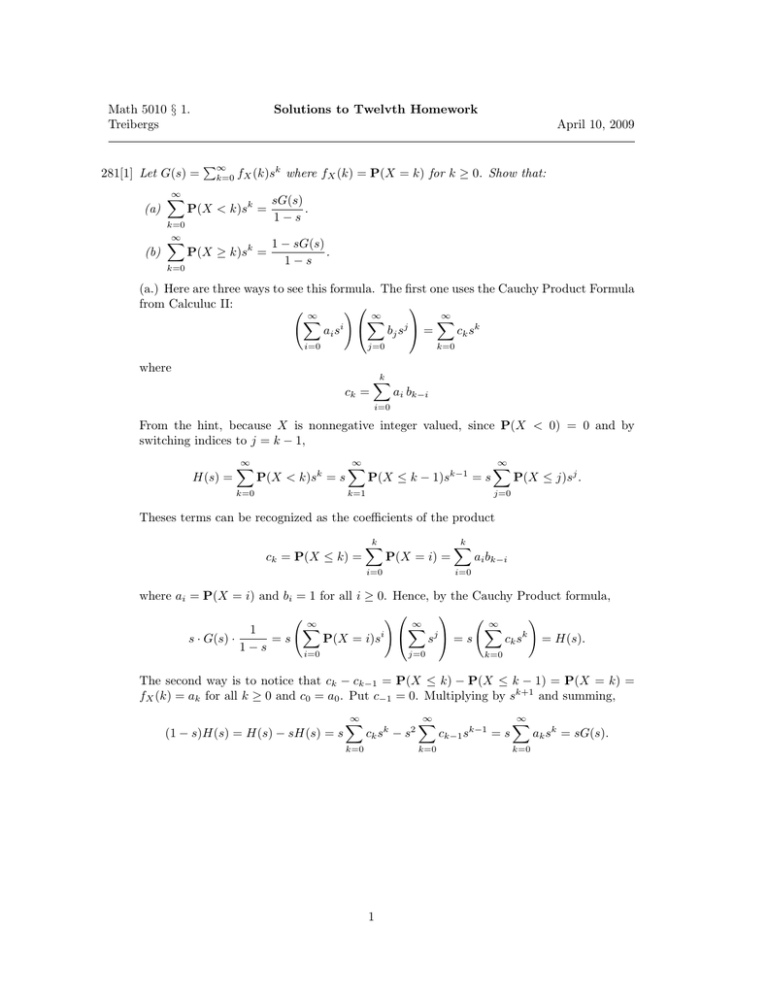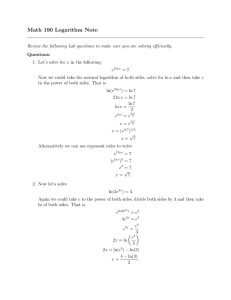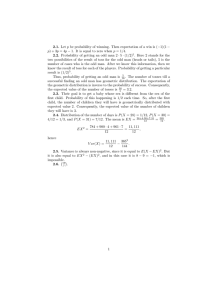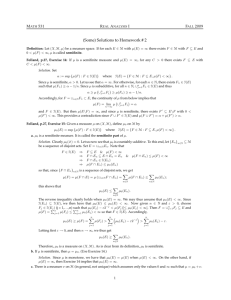Math 5010 § 1. Solutions to Twelvth Homework Treibergs April 10, 2009
advertisement

Math 5010 § 1. Treibergs Solutions to Twelvth Homework April 10, 2009 281[1] Let G(s) = (a) (b) ∞ X k=0 ∞ X P∞ k=0 fX (k)sk where fX (k) = P(X = k) for k ≥ 0. Show that: P(X < k)sk = sG(s) . 1−s P(X ≥ k)sk = 1 − sG(s) . 1−s k=0 (a.) Here are three ways to see this formula. The first one uses the Cauchy Product Formula from Calculuc II: ! ∞ ∞ ∞ X X X ai si bj sj = ck sk i=0 j=0 k=0 where ck = k X ai bk−i i=0 From the hint, because X is nonnegative integer valued, since P(X < 0) = 0 and by switching indices to j = k − 1, H(s) = ∞ X P(X < k)sk = s ∞ X P(X ≤ k − 1)sk−1 = s P(X ≤ j)sj . j=0 k=1 k=0 ∞ X Theses terms can be recognized as the coefficients of the product ck = P(X ≤ k) = k X P(X = i) = k X ai bk−i i=0 i=0 where ai = P(X = i) and bi = 1 for all i ≥ 0. Hence, by the Cauchy Product formula, ! ∞ ! ∞ ∞ X X X 1 s · G(s) · =s P(X = i)si sj = s ck sk = H(s). 1−s i=0 j=0 k=0 The second way is to notice that ck − ck−1 = P(X ≤ k) − P(X ≤ k − 1) = P(X = k) = fX (k) = ak for all k ≥ 0 and c0 = a0 . Put c−1 = 0. Multiplying by sk+1 and summing, (1 − s)H(s) = H(s) − sH(s) = s ∞ X ck sk − s2 k=0 ∞ X k=0 1 ck−1 sk−1 = s ∞ X k=0 ak sk = sG(s). A third way was discovered by some clever students in our class. The idea is to switch the order of summation, thus ∞ X P(X < k)sk = k=0 ∞ X P(X ≤ k − 1)sk k=1 = = ∞ k−1 X X P(X = j)sk k=1 j=0 ∞ X j=0 = ∞ X P(X = j) ∞ X sk k=j+1 P(X = j) j=0 sj+1 1−s ∞ = s X P(X = j)sj 1 − s j=0 = sG(s) . 1−s (b.) The second formula follows from P(X ≥ k) = 1 − P(X < k). Multiplying by sk , summing and using part (a.), ∞ X k=0 P(X ≥ k)sk = ∞ X k=0 sk − ∞ X P(X < k)sk = k=0 1 1 − sG(s) − H(s) = . 1−s 1−s A*. Consider the coupon collecting problem with three types of coupons. Let T be the number of boxes needed until you first possess all three types. Find P(T = k), E(T ) and Var(T ) using the probability generating function. The first coupon comes in the first box. Let X1 be the further number of boxes until a different coupon appears. Thus X1 is a geometric variable with probability of success p = 32 . The generating function for X1 is G1 (s) = ps 2s = . 1 − qs 3−s Let X2 be the further number of boxes until the last type of coupon appears. X2 is a geometric variable with probability if success p = 31 . Thus G2 (s) = ps s = . 1 − qs 3 − 2s The number of boxes to get all three types is T = 1 + X1 + X2 . Since X1 and X2 are independent, the generating function of the sum is the product of pgf’s. Adding one multiplies the pgf by s. Hence 2s3 G(s) = sG1 (s)G2 (s) = . (3 − 2s)(3 − s) To get the power series for G(s), it helps to cleave it into easier pieces using partial fractions. Since the denominator is factored into distinct linear factors, these occur as denominators of simpler terms with unknown constants A and B 2 A B = + . (3 − 2s)(3 − s) 3 − 2s 3 − s 2 To solve for the constants, multiply the denominators 2 = A(3 − s) + B(3 − 2s). Taking s = 3 we find B = − 32 . Taking s = 0 we find A = 43 . Adding, and simplifying denominators 2 3 4 3 2 3 4 3 s s s s − 3 = 9 2 − 9 1 . G(s) = 3 3 − 2s 3 − s 1 − 3s 1 − 3s Finally, we use the geometric series, and substituting k = j + 3, ∞ 4X G(s) = 9 j=0 j ∞ j ∞ k−1 X 2X 1 2 2 −2 k j+3 j+3 s − s = s . 3 9 j=0 3 3k−1 k=3 It follows that, for k ≥ 3, P(T = k) = fT (k) = 2k−1 − 2 . 3k−1 Assuming the derivatives exist, they give the first and second moments. Taking logarithmic derivatives G0 (s) 3 2 1 = + + , G(s) s 3 − 2s 3 − s 2 G0 (s) G00 (s) 3 4 1 − =− 2 + + . G(s) G(s)2 s (3 − 2s)2 (3 − s)2 So, using the property of pgf’s that G(1) = 1, G0 (1) 1 11 =3+2+ = , G(1) 2 2 2 2 G0 (1) 1 5 G00 (1) 00 0 − = −3 + 4 + = . G (1) − G (1) = G(1) G(1)2 4 4 G0 (1) = The expectation and variance are E(T ) = G0 (1) = 11 = 5 12 , 2 2 5 11 Var(T ) = G00 (1) − G0 (1) + G0 (1) = + = 6 34 . 4 2 B*. Flip a fair coin repeatedly until you get two consecutive heads. This takes X flips. Derive the pgf. Use it to find the expectation and the variance of X. Suppose P(head on nth spin) = p (for us p = 12 .) Following the argument in the text, let’s condition on the first couple of tosses. If the first toss is tail, then the conditional expectation of the number of tosses is the same as at the outset, except that one more toss (the first) was used. Thus E(sX | T1 ) = E(sX+1 ) = s E(sX ). If the first two tosses are a head then tail, then the conditional expectation of the number of tosses is the same as at the outset, except that two more tosses were used. Thus E(sX | H1 T2 ) = E(sX+2 ) = s2 E(sX ). 3 If the first two tosses are a heads then two consecutive heads have occurred and X = 2. Thus E(sX | H1 H2 ) = E(s2 ) = s2 . Using the partitioning formula for expectation, E(sX ) = E(sX | T1 ) P(T1 ) + E(sX | H1 T2 ) P(H1 T2 ) + E(sX | H1 H2 ) P(H1 H2 ) = s E(sX )q + s2 E(sX )pq + s2 p2 . Solving for E(sX ) we get GX (s) = E(sX ) = p2 s2 . 1 − qs − pqs2 Taking derivatives of the logarithm we see that G0X (s) 2 q + 2pqs , = + GX (s) s 1 − qs − pqs2 2 G0X (s) G00X (s) 2 2pq (q + 2pqs)2 − =− 2 + + 2 . 2 2 GX (s) GX (s) s 1 − qs − pqs 1 − qs − pqs2 So, using the property of pgf’s that G(1) = 1, q + 2pq 1+p G0 (1) =2+ = , G(1) 1 − q − pq p2 2 2 G0 (1) (q + 2pq)2 2pq G00 (1) 00 0 − + = −2 + G (1) − G (1) = 2 G(1) G(1)2 1 − q − pq 1 − q − pq G0 (1) = = −2 + 2q q 2 (1 + 2p)2 + . p p4 Thus the expectation and variance for p = 1 2 are E(T ) = G0 (1) = 6, 2 Var(T ) = G00 (1) − G0 (1) + G0 (1) = 16 + 6 = 22. 4






